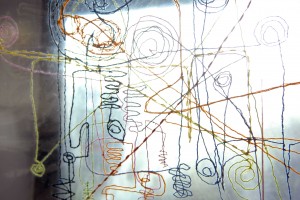In their essay titled ‘A/r/tography as Practice-Based Research’ (in the book Being with A/r/tography), Rita Irwin (University of British Columbia) and Stephanie Springgay (University of Toronto) explain the ideals and the notions of a/r/tography as a methodology associated with living inquiry. The book presents a collection of essays that display the potential of a/r/tographic research and Irwin and Springgay’s essay is the introductory chapter.
A/r/tography is explored under the umbrella of practice-based research as a methodology that has multiple ways of being explored and discovered. The multiplicity of this methodology is part of what makes a/r/tography unique. This type of work has developed from a “fluid and constantly evolving community” that is willing to work outside of the conventional methodological boundaries in order to present research that is able to extend our ideas of education.
A/r/tography as a term is developed purposefully to include the ‘/’. The ‘/’ is used to present an equality and coexistence between the three identities that create the term – artist / researcher / teacher. Along side this the notion of ‘graphy’ makes associations with text and thus, presents a connection between the art and text, aligning the arts alongside the narrative as a joint initiative. “A/r/tography is a coming together of art and graphy, or image and word.” (Springgay, Irwin & Wilson Kind, p.900).
One aspect of a/r/tography that has perked my interest is its associations with Deleuze and Guattari. Deleuze and Guattari are fundamental in my research project since their constructs such as ‘images of thought’ and the ‘rhizome’ are integral to my thinking and methods and personal beliefs on the structure and development of our identity. Irwin and Springgay explain how,
“A/r/tography is a research methodology that entangles and performs what Gilles Deleuze and Felix Guattari (1987) refer to as a rhizome. A rhizome is an assemblage that moves and flows in dynamic momentum. The rhizome operates by variation, perverse mutation, and flows of intensities that penetrate meaning, […] It is an interstitial space, open and vulnerable where meanings and understandings are interrogated and ruptured. Building on the concept of the rhizome, a/r/tography radically transforms the idea of theory as an abstract system” (p.xx)
All this too-ing and fro-ing and lack of concreteness is what is so attractive about a/r/tography and its philosophical associations. The notion that we are all individuals, that we take different paths, that we continue to develop in ways that mimic rhizomatic development are all key characteristics. So to is the interactions and the paths that are derived from the ‘interruptions’ that are created, these paths are sometimes influences by others and it is these ‘in-between’ moments that open up new spaces and directions. Irwin and Springgay cite the work of Elizabeth Grosz with reference to the in-between,
“The space of the in-between is the locus for social, cultural and natural transformations: it is not simply a convenient space for movements and realignments but in fact the only place – the place around identities, between identities” (Grosz as cited in Springgay etal., p.xx)
The in-between is exactly where a/r/tography is situated, “where theory-as-practice-as-process-as-complication intentionally unsettles perception and knowing through living inquiry.” (p.xxi) Having created my collages in the past this is exactly the process and theoretical notions that I have explored, perhaps unknowingly at times, in order to pursue my own autobiographical understanding of identity. A/r/tography presents a clear way of moving forward with others for my research and aligns many of the thoughts that I have had around the rhizome, Deleuze & Guattari, as well as the use of arts-based inquiry as a method of collecting data from participants.
 (image from www.kyrapollitt.com)
(image from www.kyrapollitt.com)
But why should we see a/r/tography as a methodology and not a method associated with qualitative research? Springgay, Irwin and Wilson Kind make a clear case, proclaiming that:
“Our arguments stem from a belief that if forms of arts-based research are to be taken seriously as emerging fields within educational research, then perhaps they need to be understood as methodologies in their own right, not as extensions of qualitative research. […] interdisciplinarity not as a patchwork of different disciplines and methodologies but as a loss, a shift, or a rupture where in absence, new courses of action unfold.” (Springgay, Irwin & Wilson Kind, p.898)
Practice-based and arts-based research have struggle to achieve their credentials in academic circles. Yet, very often they are praised for their ingenuity and the ways in which they are able to use visual methods to develop different perspective and access the unconscious mind. Therefore, I think that Springgay, Irwin and Wilson Kind have an excellent point. If arts-based inquiry and narrative inquiry are the methods that help to explore aspects of a/r/tography. It is a/r/tography that presents the philosophical grounding and the methodology upon which to work.
References:
Springgay, S., Irwin, R. L., Leggo, C., & Gouzouasis, P. (Eds.). (2008). Being with A/r/tography. Rotterdam: Sense Publishers.
Springgay, S.; Irwin, R. & Wilson Kind, S. (2005) ‘A/r/tography as Living Inquiry Through Art and Text,’ Qualitative Inquiry. Vol. 11, No. 6. p. 897-912.
Website:
A/r/tography – http://m1.cust.educ.ubc.ca/Artography/
*image from www.kyrapollitt.com a/r/tography for more information about this piece check out the blog entry at http://nanafroufrou.wordpress.com/2013/02/03/a-tale-told-and-retold/
Update:
Check the new special issue of the e-journal Multi-Disciplinary Journal in the Arts on
A/r/tography and the Arts @
http://web.education.unimelb.edu.au/UNESCO/ejournal/ejournal_vol3iss1.html
